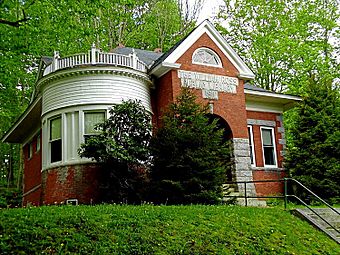Chaplin Historic District facts for kids
Quick facts for kids |
|
|
Chaplin Historic District
|
|

The former William Ross Public Library building
|
|
| Location | Chaplin St., Chaplin, Connecticut |
|---|---|
| Area | 40 acres (16 ha) |
| Built | 1815 |
| Architectural style | Greek Revival, Federal |
| NRHP reference No. | 78002856 |
| Added to NRHP | October 11, 1978 |
The Chaplin Historic District is a special area in Chaplin, Connecticut. It's like a time capsule! This district was added to the National Register of Historic Places in 1978. This means it's a place with important history and buildings.
The district covers the old village center of Chaplin. It stretches for about 0.8 miles (1.3 km) along Chaplin Street. Most of the buildings here were built in the early 1800s.
Contents
What Makes the Chaplin Historic District Special?
The heart of the district is the Congregational Church. It was built between 1812 and 1815. This church sits on a small hill, looking over the street.
Historic Buildings You Can See
Most of the buildings in the district are old wooden houses. They show off two popular styles from the past:
- Federal style: This style was popular in the United States from about 1780 to 1830. Buildings often have simple, elegant designs.
- Greek Revival style: This style became popular a bit later, from about 1825 to 1860. It was inspired by ancient Greek temples.
One special building is the Witter House. It's made of brick, which is unusual for the area. This house is so important that it's listed on the National Register of Historic Places all by itself!
Besides houses and the church, other important buildings include:
- The old town hall, built in 1840.
- The Ross Memorial Library building, built in 1911. It has a Colonial Revival style.
- Eaton's Store, which was built in 1850.
How Chaplin Became a Town
The area that is now Chaplin was first settled in the 1700s. Back then, it was split between three towns: Mansfield, Windham, and Hampton.
Why Chaplin Needed Its Own Church
It was hard for people living in this area to get to the churches in those other towns. So, they wanted their own church closer to home. Benjamin Chaplin, who passed away in 1795, left money to build a church near his home.
A village grew up around this new church. Because of this, Chaplin officially became its own town in 1822.
A Town Preserved in Time
Chaplin's village center is unique in Connecticut. It developed a bit later than other towns. This means it's a great example of how towns were planned in the early 1800s.
The town center was not built near a major river, so it didn't have water power for factories. Also, railroads were built around it, not through it. This meant Chaplin didn't become a big industrial center. This helped keep its historic look. Even when Connecticut Route 198 was built in the 20th century, it went around the village, helping to preserve it even more.



